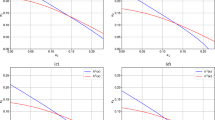Abstract
In this paper we study an optimal asset liquidation problem for a discrete-time stochastic dynamics, involving a variant of the binomial price model that incorporates both a random environment present in the market and permanent shocks. Our aim is to find an optimal plan for the sale of assets at certain appropriate times to obtain the highest possible expected reward. To achieve this goal, the financial problem is presented as an impulsive control model in discrete time, whose solution is based on the well-known dynamic programming method. Under this method we obtain: (1) the seller’s optimal expected profit and (2) optimal sale strategies. In addition we mention how one can use the so-called potential function to analyze the influence of the environment on the trend of the prices and as a byproduct to infer how this trending influences the optimal sale strategies. We provide numerical simulations to illustrate our findings.




Similar content being viewed by others
Data availibility
Data sharing is not applicable to this article as no datasets were generated or analyzed during the current study.
References
Alfonsi A, Schied A, Schulz A (2008) Constrained portfolio liquidation in a limit order book model. Banach Center Publications 83:9–25
Alfonsi A, Schied A, Schulz A (2010) Optimal execution strategies in limit order books with general shape functions. Quantitative Finance 10:143–157
Almgren R, Chriss N (1999) Value under liquidation. Risk 12:61–63
Almgren R, Chriss N (2000) Optimal execution of portfolio transactions. Journal of Risk 3(2):5–39
Almgren R, Lorenz J (2011) Mean-variance optimal adaptive execution. Applied Mathematical Finance 18:395–422
Bertsimas D, Lo D (1998) Optimal control of execution costs. Journal of Financial Markets 1(1):1–50
Cartea Á, Jaimungal S (2016) Incorporating order-flow into optimal execution. Mathematics and Financial Economics 10(3):339–364
Cartea Á, Jaimungal S (2016) A closed-form execution strategy to target volume weighted average price. SIAM Journal on Financial Mathematics 7(1):760–785
Castro I, Pacheco CG (2020) Modeling and pricing with a random walk in random environment, International Journal of Financial Engineering, 7(04), pp. 2050053-1—2050053-20
Cox JC, Ross SA, Rubinstein M (1979) Option pricing: A simplified approach. Journal of Financial Economics 7(3):229–263
Engle R, Ferstenberg R (2007) Execution risk. The Journal of Trading 2(2):10–20
Fukasawa M, Ohnishi M, Shimoshimizu M (2021) Discrete-time optimal execution under a generalized price impact model with Markovian exogenous orders. International Journal of Theoretical and Applied Finance, 24(05), pp. 2150025-1–2150025-43
Gatheral J, Schied A (2011) Optimal trade execution under geometric Brownian motion in the Amgren Chriss framework. International Journal of Theoretical and Applied Finance 14(3):353–368
Gatheral J, Schied A, Slynko A (2012) Transient linear price impact and Fredholm integral equations. Mathematical Finance 22(3):445–474
Guéant O, Pu J (2017) Option pricing and hedging with execution costs and market impact. Mathematical Finance 27:803–831
Guo X, Zervos M (2015) Optimal execution with multiplicative price impact. SIAM Journal on Financial Mathematics 6(1):281–306
Hernandez-del-Valle G, Sun Y (2012) Optimal execution of derivatives a Taylor expansion approach. Stochastic Systems: Optimization, Control and Applications, Birkhauser, pp. 157–163
He H, Mamayski H (2005) Dynamic trading policies with price impact. Journal of Economic Dynamics and Control 29(5):891–930
Hughes BD (1995) Random walks and random environments: random walks, vol 1. Oxford University Press, Oxford
Hughes BD (1996) Random walks and random environments: random environments, vol 2. Oxford University Press, Oxford
Hull JC (2006) Options, futures and other derivatives, 6th edn. Prentince Hall, New Jersey
Jasso-Fuentes H, Menaldi JL, Prieto-Rumeau T (2020) Discrete-time hybrid control in Borel spaces. Applied Mathematics Optimization 81(2):409–441
Lehalle CA, Neuman E (2014) Optimal liquidation in a limit order book for a risk-averse investor. Mathematical Finance 24(4):696–727
Lokka A (2019) Incorporating signals into optimal trading. Finance and Stochastics 23(2):275–311
Machnes Y (2006) The trading volume of currency options and the spot exchange rate. Emerging Markets Finance and Trade 42(3):91–97
Obizhaeva A, Wang J (2013) Optimal trading strategy and supply/demand dynamics. Journal of Financial Markets 16(1):1–32
Ohnishi M, Shimoshimizu M (2020) Optimal and equilibrium execution strategies with generalized price impact. Quantitative Finance 20(10):1625–1644
Ohnishi M, Shimoshimizu M (2022) Optimal pair-trade execution with generalized cross-impact. Asia-Pacific Financial Markets 29:253–289
Papadimitriou C, Tsitsiklis J (1987) The Complexity of Markov Decision Processes. Mathematics of Operations Research 12(3):441–450
Pliska SR (1997) Introduction of Mathematical Finance: Discrete Time Models. Blackwell Publishing, New York
Predoiu S, Shaiket G, Shreve S (2011) Optimal execution in a general one-sided limit order book. SIAM Journal on Financial Mathematics 2:181–204
Révész P (2013) Random walk in random and non-random environments. World Scientific, Singapore
Sarwar G (2003) The interrelation of price volatility and trading volume of currency options. Journal of Futures Markets 23(7):681–700
Sinai YG (1982) The limiting behavior of a one-dimensional random walk in a random medium. Theory of Probability and Its Applications 27(2):256–268
Funding
This research was funded in part by: Conacyt scholarship No. 1220142 “2do Año de continuidad de estancias posdoctorales por México 2021”, and by Grants: Conacyt Ciencia de Frontera No. 87787 and PRODEP-2021 No. CA-38.
Author information
Authors and Affiliations
Corresponding author
Additional information
Publisher's Note
Springer Nature remains neutral with regard to jurisdictional claims in published maps and institutional affiliations.
Rights and permissions
Springer Nature or its licensor (e.g. a society or other partner) holds exclusive rights to this article under a publishing agreement with the author(s) or other rightsholder(s); author self-archiving of the accepted manuscript version of this article is solely governed by the terms of such publishing agreement and applicable law.
About this article
Cite this article
Jasso-Fuentes, H., Pacheco, C.G. & Salgado-Suárez, G.D. A discrete-time optimal execution problem with market prices subject to random environments. TOP 31, 562–583 (2023). https://doi.org/10.1007/s11750-022-00652-2
Received:
Accepted:
Published:
Issue Date:
DOI: https://doi.org/10.1007/s11750-022-00652-2



